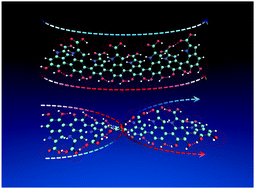Charge transfer in DHICA eumelanin-like oligomers: role of hydrogen bonds†
Abstract
Eumelanin is a versatile bio-polymer with a heterogeneous structure and atypical functionalities. The constituent parts of eumelanin can be used to engineer systems with spectacular properties. We will describe some design principles to accentuate the charge transfer properties in eumelanin, especially those containing dihydroxyindole carboxylic acid (DHICA). We will show that the oligomers of DHICA can form isomers (atropisomers) of almost equivalent stability and the difference in charge transfer properties between these isomers is strongly dependent on the presence of inter-monomer hydrogen bonds.

- This article is part of the themed collection: (Photo)electrocatalysis for renewable energy


 Please wait while we load your content...
Please wait while we load your content...